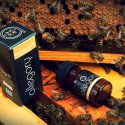What is royal jelly
It is a creamy substance secreted by the hypopharyngeal glands of young worker bees. The name Royal Jelly comes from the fact that larvae who are intended to be queens, and adults queens exclusively fed with a large amount of this food. The royal jelly is the determining factor that a bee turns from worker to queen.
Chemical composition:
The average chemical composition is 67% moisture, 12.5% protein, total fatty acids 5%, 1% total sugar, minerals (ash) 1% and 3.5% other unidentified as well as vitamins and minerals. Also some of the percentage consists of various compounds such as 10-hydroxy-decenoic acid and pantothenic acid.
Natural properties:
The color of royal jelly is essential since is an indicator of freshness and appropriateness. The fresh pulp has whitish bright color. But when it comes into contact with air or exposed to the light, the color changes to light yellow and then to dark gray. This change is due to enzymes that oxidize some substances and destroy it. Is slightly pungent aroma and sour taste due to the very low ph (3,5-4,5).
Nutritional value:
It improves the overall mood, increases the capacity to work and helps people to gain more mental and physical strength. It has antibacterial and antiseptic properties and helps significantly in the female body milk production after birth. It also helps men to improve their sexual life. Royal jelly contributes to better treatment of rheumatic arthritis. Stimulates the aging body and finds application in pediatric treatment helping children with anemia, pneumonia, bacterial infections, etc.
Dosage:
The recommended daily consumption of royal jelly is one quarter of a gram (1 teaspoon in the packaging). For young children, consult your pediatrician.
Packaging:
Available in 10 g jar.




